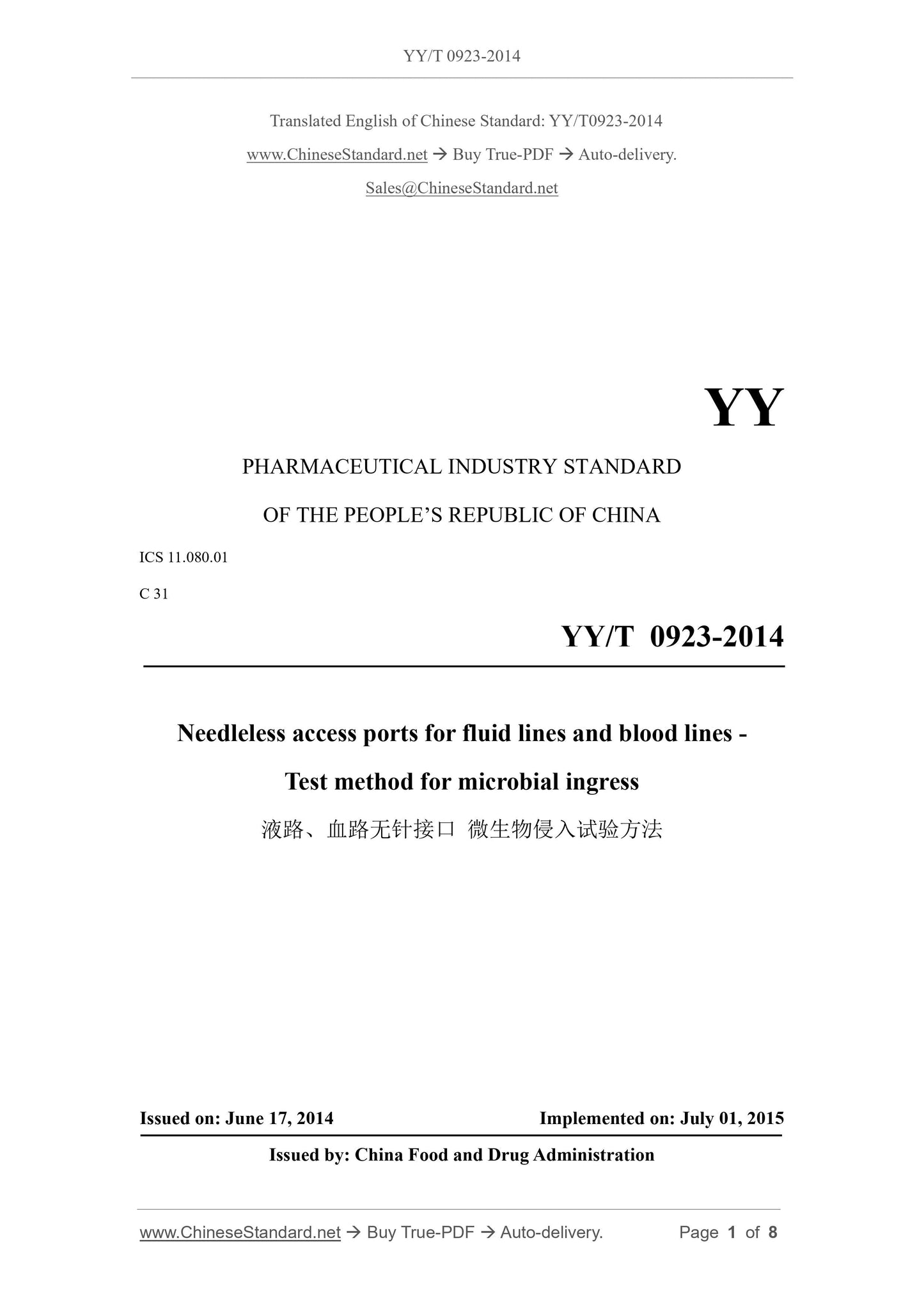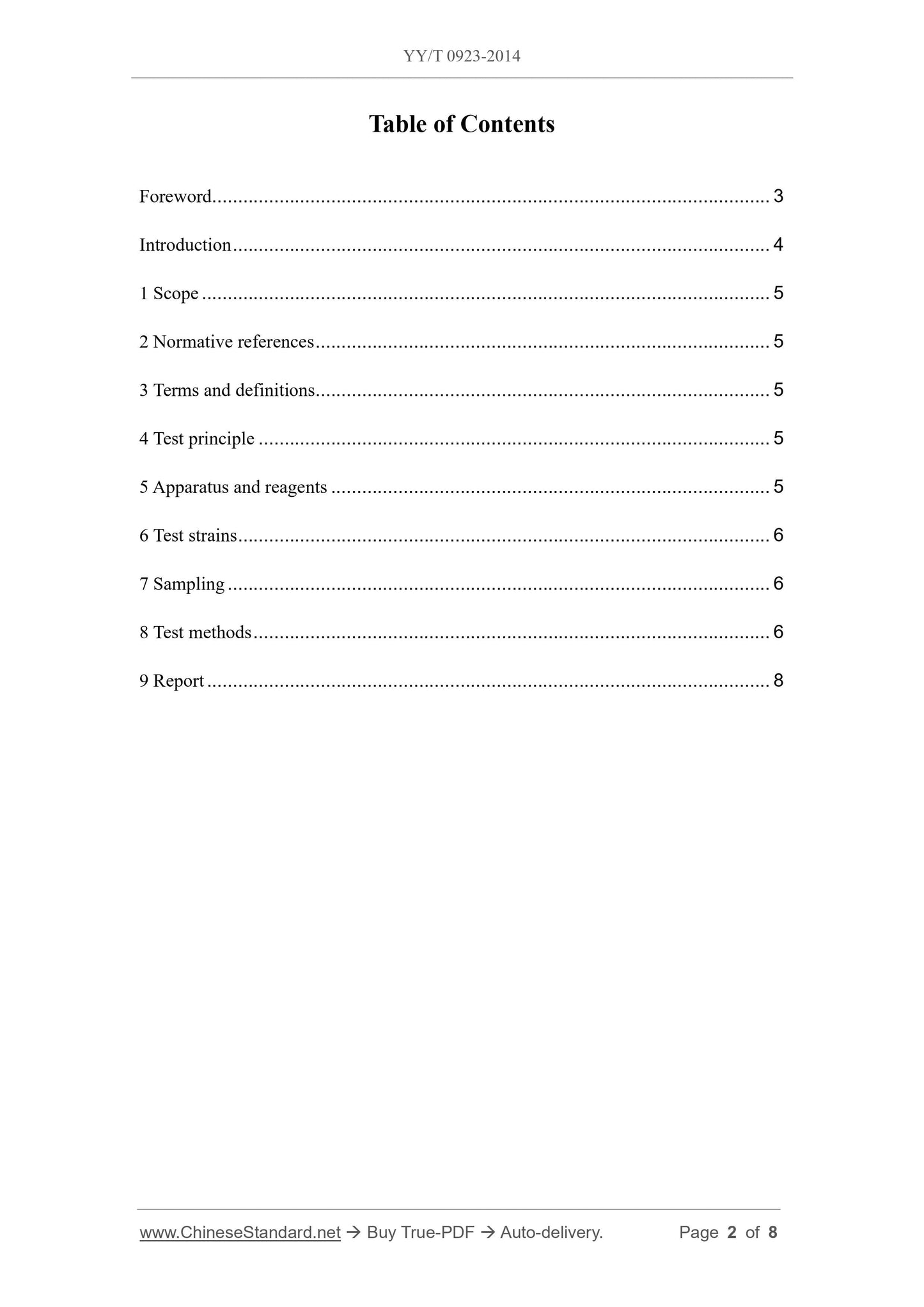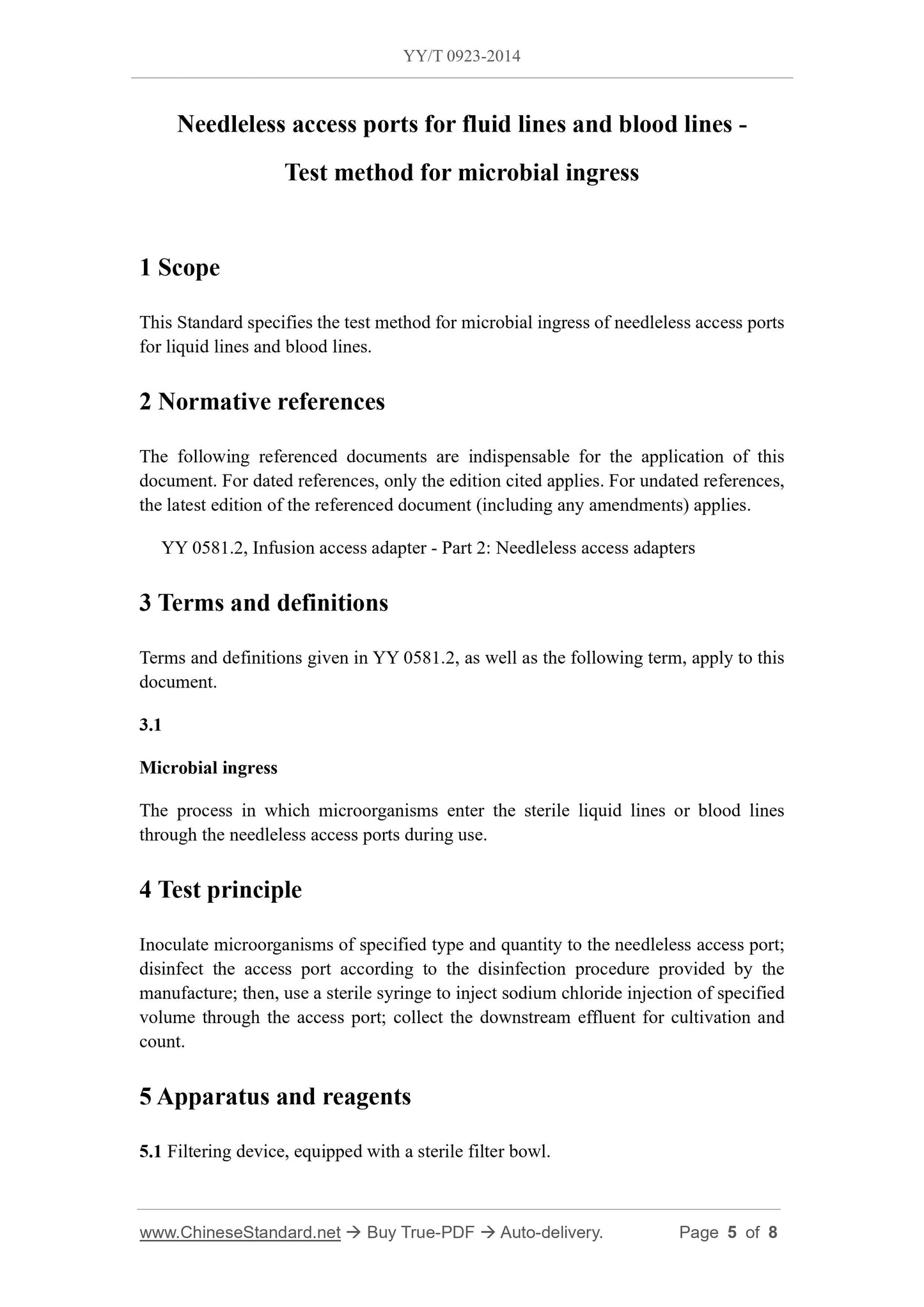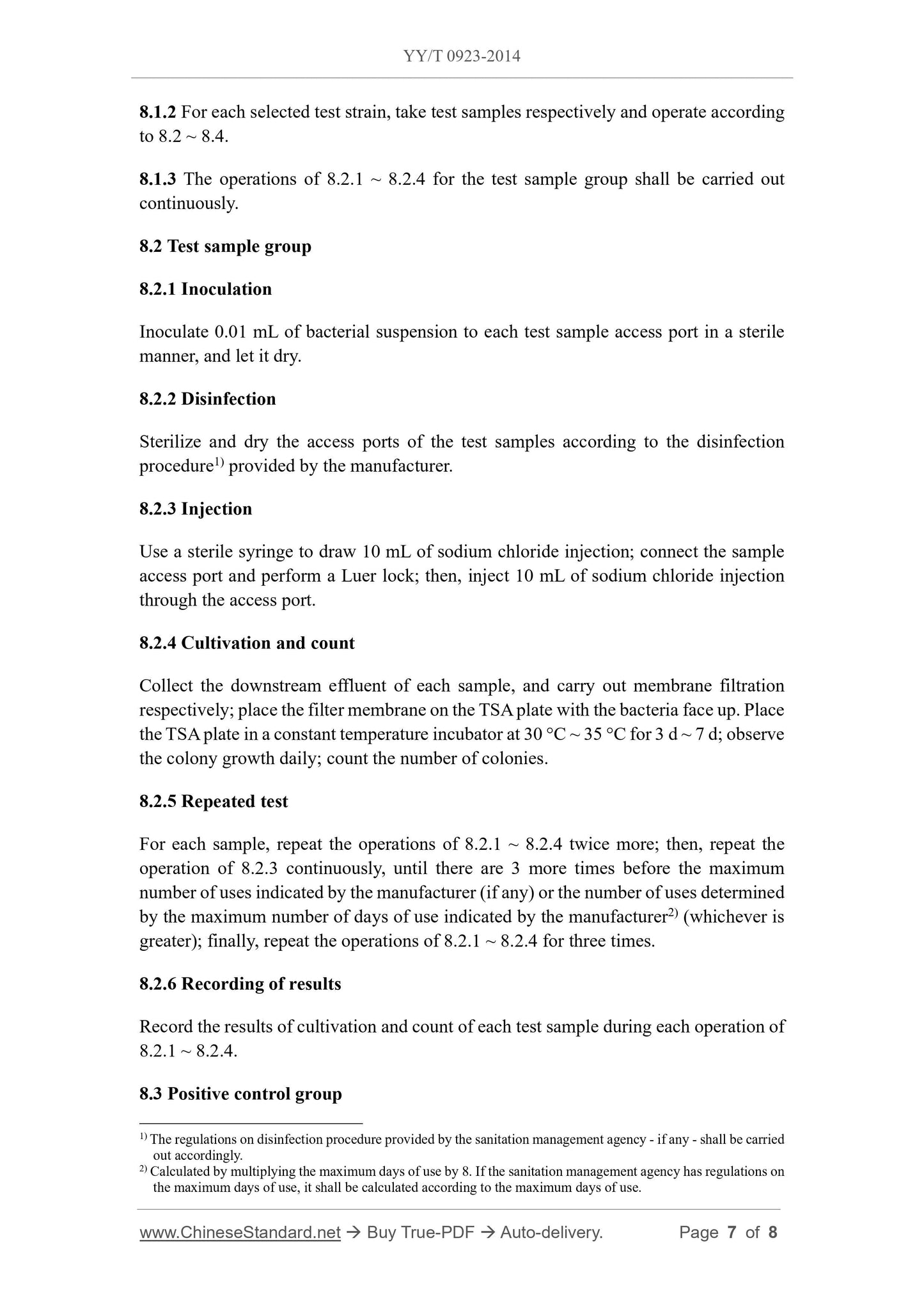1
/
von
4
PayPal, credit cards. Download editable-PDF & invoice in 1 second!
YY/T 0923-2014 English PDF (YYT0923-2014)
YY/T 0923-2014 English PDF (YYT0923-2014)
Normaler Preis
$155.00 USD
Normaler Preis
Verkaufspreis
$155.00 USD
Grundpreis
/
pro
Versand wird beim Checkout berechnet
Verfügbarkeit für Abholungen konnte nicht geladen werden
Delivery: 3 seconds. Download true-PDF + Invoice.
Get QUOTATION in 1-minute: Click YY/T 0923-2014
Historical versions: YY/T 0923-2014
Preview True-PDF (Reload/Scroll if blank)
YY/T 0923-2014: Needleless accedd ports for fluid lines and blood lines. Test method for microbial ingress
YY/T 0923-2014
PHARMACEUTICAL INDUSTRY STANDARD
ICS 11.080.01
C 31
Needleless access ports for fluid lines and blood lines -
Test method for microbial ingress
ISSUED ON. JUNE 17, 2014
IMPLEMENTED ON. JULY 01, 2015
Issued by. China Food and Drug Administration
Table of Contents
Foreword... 3
Introduction... 4
1 Scope... 5
2 Normative references... 5
3 Terms and definitions... 5
4 Test principle... 5
5 Apparatus and reagents... 5
6 Test strains... 6
7 Sampling... 6
8 Test methods... 6
9 Report... 8
Needleless access ports for fluid lines and blood lines -
Test method for microbial ingress
1 Scope
This Standard specifies the test method for microbial ingress of needleless access ports
for liquid lines and blood lines.
2 Normative references
The following referenced documents are indispensable for the application of this
document. For dated references, only the edition cited applies. For undated references,
the latest edition of the referenced document (including any amendments) applies.
YY 0581.2, Infusion access adapter - Part 2.Needleless access adapters
3 Terms and definitions
Terms and definitions given in YY 0581.2, as well as the following term, apply to this
document.
3.1
Microbial ingress
The process in which microorganisms enter the sterile liquid lines or blood lines
through the needleless access ports during use.
4 Test principle
Inoculate microorganisms of specified type and quantity to the needleless access port;
disinfect the access port according to the disinfection procedure provided by the
manufacture; then, use a sterile syringe to inject sodium chloride injection of specified
volume through the access port; collect the downstream effluent for cultivation and
count.
5 Apparatus and reagents
5.1 Filtering device, equipped with a sterile filter bowl.
8.1.2 For each selected test strain, take test samples respectively and operate according
to 8.2 ~ 8.4.
8.1.3 The operations of 8.2.1 ~ 8.2.4 for the test sample group shall be carried out
continuously.
8.2 Test sample group
8.2.1 Inoculation
Inoculate 0.01 mL of bacterial suspension to each test sample access port in a sterile
manner, and let it dry.
8.2.2 Disinfection
Sterilize and dry the access ports of the test samples according to the disinfection
procedure1) provided by the manufacturer.
8.2.3 Injection
Use a sterile syringe to draw 10 mL of sodium chloride injection; connect the sample
access port and perform a Luer lock; then, inject 10 mL of sodium chloride injection
through the access port.
8.2.4 Cultivation and count
Collect the downstream effluent of each sample, and carry out membrane filtration
respectively; place the filter membrane on the TSA plate with the bacteria face up. Place
the TSA plate in a constant temperature incubator at 30 °C ~ 35 °C for 3 d ~ 7 d; observe
the colony growth daily; count the number of colonies.
8.2.5 Repeated test
For each sample, repeat the operations of 8.2.1 ~ 8.2.4 twice more; then, repeat the
operation of 8.2.3 continuously, until there are 3 more times before the maximum
number of uses indicated by the manufacturer (if any) or the number of uses determined
by the maximum number of days of use indicated by the manufacturer2) (whichever is
greater); finally, repeat the operations of 8.2.1 ~ 8.2.4 for three times.
8.2.6 Recording of results
Record the results of cultivation and count of each test sample during each operation of
8.2.1 ~ 8.2.4.
8.3 Positive control group
1) The regulations on disinfection procedure provided by the sanitation management agency - if any - shall be carried
out accordingly.
2) Calculated by multiplying the maximum days of use by 8.If the sanitation management agency has regulations on
the maximum days of use, it shall be calculated according to the maximum days of use.
Get QUOTATION in 1-minute: Click YY/T 0923-2014
Historical versions: YY/T 0923-2014
Preview True-PDF (Reload/Scroll if blank)
YY/T 0923-2014: Needleless accedd ports for fluid lines and blood lines. Test method for microbial ingress
YY/T 0923-2014
PHARMACEUTICAL INDUSTRY STANDARD
ICS 11.080.01
C 31
Needleless access ports for fluid lines and blood lines -
Test method for microbial ingress
ISSUED ON. JUNE 17, 2014
IMPLEMENTED ON. JULY 01, 2015
Issued by. China Food and Drug Administration
Table of Contents
Foreword... 3
Introduction... 4
1 Scope... 5
2 Normative references... 5
3 Terms and definitions... 5
4 Test principle... 5
5 Apparatus and reagents... 5
6 Test strains... 6
7 Sampling... 6
8 Test methods... 6
9 Report... 8
Needleless access ports for fluid lines and blood lines -
Test method for microbial ingress
1 Scope
This Standard specifies the test method for microbial ingress of needleless access ports
for liquid lines and blood lines.
2 Normative references
The following referenced documents are indispensable for the application of this
document. For dated references, only the edition cited applies. For undated references,
the latest edition of the referenced document (including any amendments) applies.
YY 0581.2, Infusion access adapter - Part 2.Needleless access adapters
3 Terms and definitions
Terms and definitions given in YY 0581.2, as well as the following term, apply to this
document.
3.1
Microbial ingress
The process in which microorganisms enter the sterile liquid lines or blood lines
through the needleless access ports during use.
4 Test principle
Inoculate microorganisms of specified type and quantity to the needleless access port;
disinfect the access port according to the disinfection procedure provided by the
manufacture; then, use a sterile syringe to inject sodium chloride injection of specified
volume through the access port; collect the downstream effluent for cultivation and
count.
5 Apparatus and reagents
5.1 Filtering device, equipped with a sterile filter bowl.
8.1.2 For each selected test strain, take test samples respectively and operate according
to 8.2 ~ 8.4.
8.1.3 The operations of 8.2.1 ~ 8.2.4 for the test sample group shall be carried out
continuously.
8.2 Test sample group
8.2.1 Inoculation
Inoculate 0.01 mL of bacterial suspension to each test sample access port in a sterile
manner, and let it dry.
8.2.2 Disinfection
Sterilize and dry the access ports of the test samples according to the disinfection
procedure1) provided by the manufacturer.
8.2.3 Injection
Use a sterile syringe to draw 10 mL of sodium chloride injection; connect the sample
access port and perform a Luer lock; then, inject 10 mL of sodium chloride injection
through the access port.
8.2.4 Cultivation and count
Collect the downstream effluent of each sample, and carry out membrane filtration
respectively; place the filter membrane on the TSA plate with the bacteria face up. Place
the TSA plate in a constant temperature incubator at 30 °C ~ 35 °C for 3 d ~ 7 d; observe
the colony growth daily; count the number of colonies.
8.2.5 Repeated test
For each sample, repeat the operations of 8.2.1 ~ 8.2.4 twice more; then, repeat the
operation of 8.2.3 continuously, until there are 3 more times before the maximum
number of uses indicated by the manufacturer (if any) or the number of uses determined
by the maximum number of days of use indicated by the manufacturer2) (whichever is
greater); finally, repeat the operations of 8.2.1 ~ 8.2.4 for three times.
8.2.6 Recording of results
Record the results of cultivation and count of each test sample during each operation of
8.2.1 ~ 8.2.4.
8.3 Positive control group
1) The regulations on disinfection procedure provided by the sanitation management agency - if any - shall be carried
out accordingly.
2) Calculated by multiplying the maximum days of use by 8.If the sanitation management agency has regulations on
the maximum days of use, it shall be calculated according to the maximum days of use.
Share








